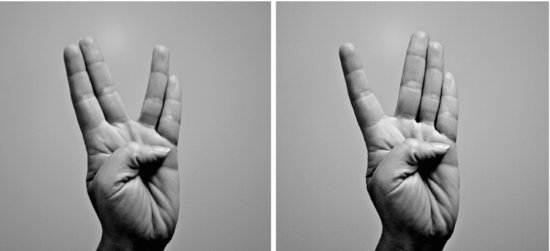9.7 Design Resolution
The number of factors occurring in the defining relationship is called the resolution and describes the degree of confounding in a fractional factorial design. The higher the resolution, the more information is obtained from the experiment. The resolution is written using roman numerals. For example, if the defining relation is I = ABCD the resolution is IV (four). It is easy to visualize the types of confounding that occur with a resolution of IV by holding up four fingers on one hand. Figure 9.7 shows that you can group them two and two (index and middle finger in one group, ring and little finger in the other). This represents confounding between a pair of two-way interactions. You can also group them as one plus three (for instance index finger in one group and the rest in the other). This represents confounding between main effects and three-way interactions.
Figure 9.7 A simple technique for translating resolution into confounding patterns, here shown for resolution IV. Grouping four fingers two and two represents confounding between a pair of two-way interactions. Grouping them one and three corresponds to confounding between a main effect and a three-way interaction. © Öivind Andersson.

With a resolution V design you could either group the five fingers as one plus four or as two plus three. This represents confounding between main effects and four-way interactions, and between two- and three-way interactions, respectively.
Using this method it is easy to see that resolution II designs are not useful, since they confound main effects with other main effects. Similarly, designs with a resolution above V may be considered wasteful as they estimate interactions of such high order that they are unlikely to occur. Resolutions from III to V are most frequent. Table 9.7 gives the resolutions of fractional factorial designs for given numbers of factors and runs. Those who run fractional factorial experiments will probably find this table helpful for choosing an appropriate design. Note that when five or more factors are used, there are fractional factorial designs that can be preferred over full factorials as they give sufficiently detailed information in fewer runs. Fractional designs, in other words, are not only useful for screening.
Table 9.7 Resolutions for fractional factorial designs with various numbers of factors and treatments.

